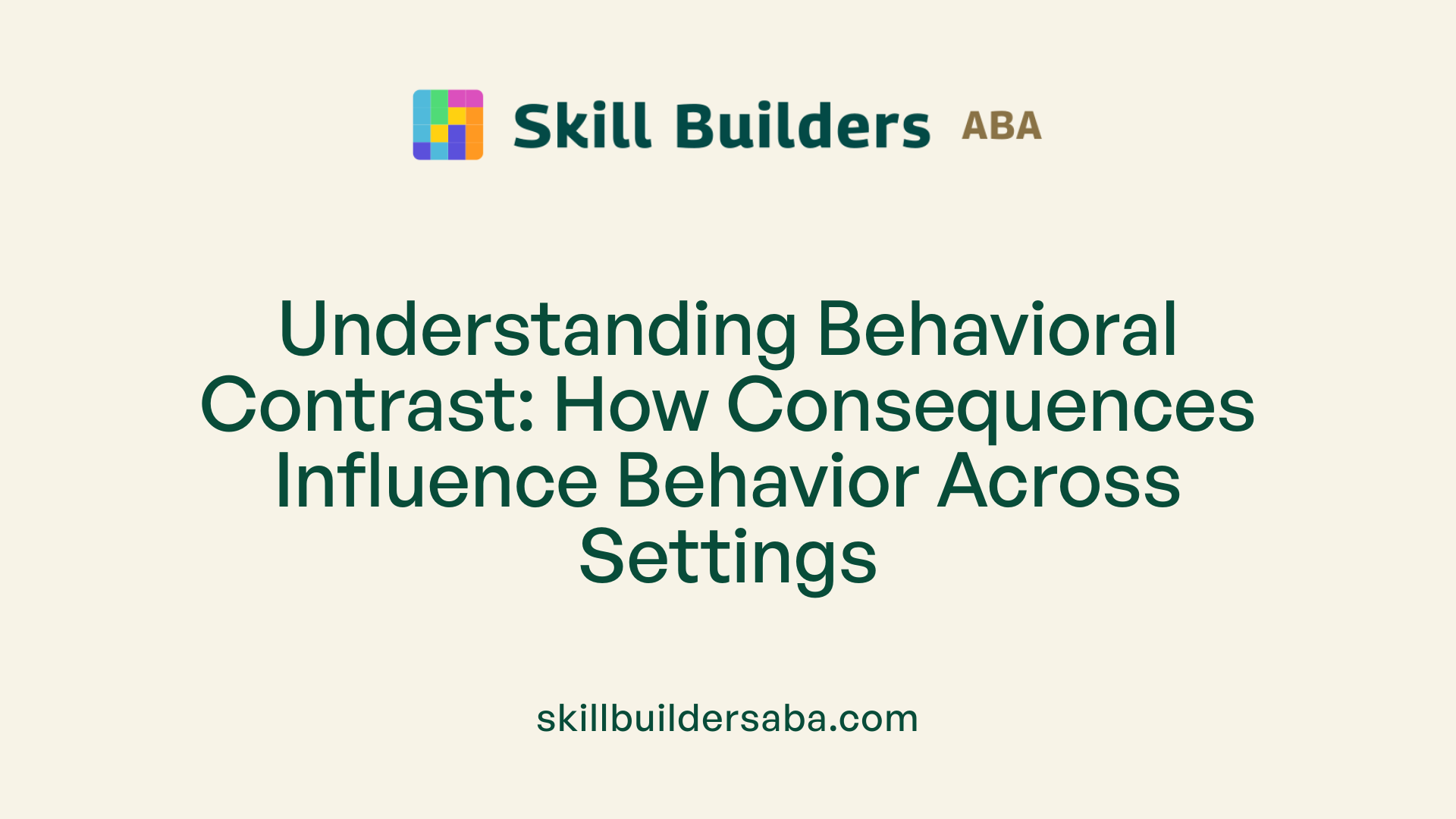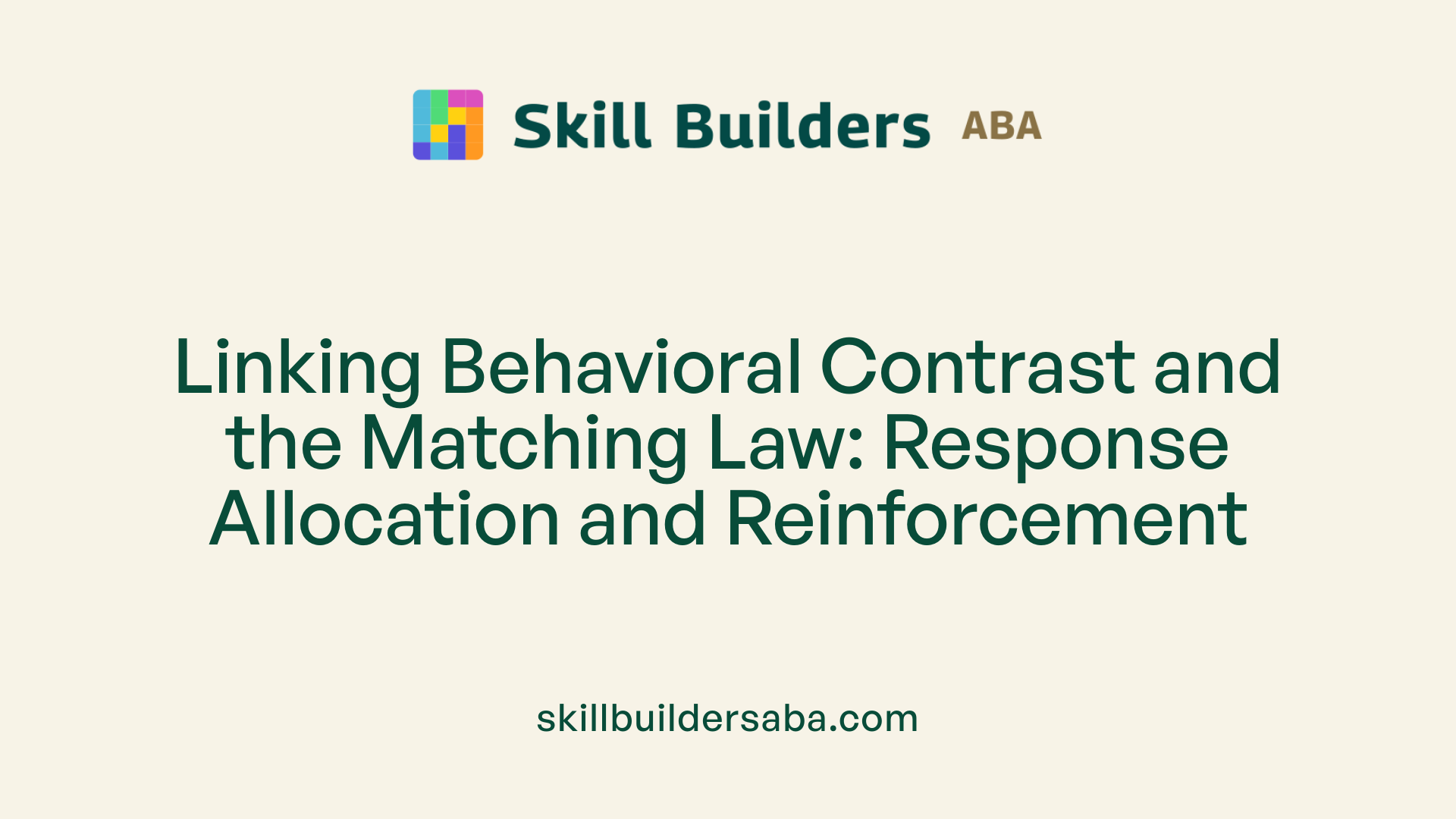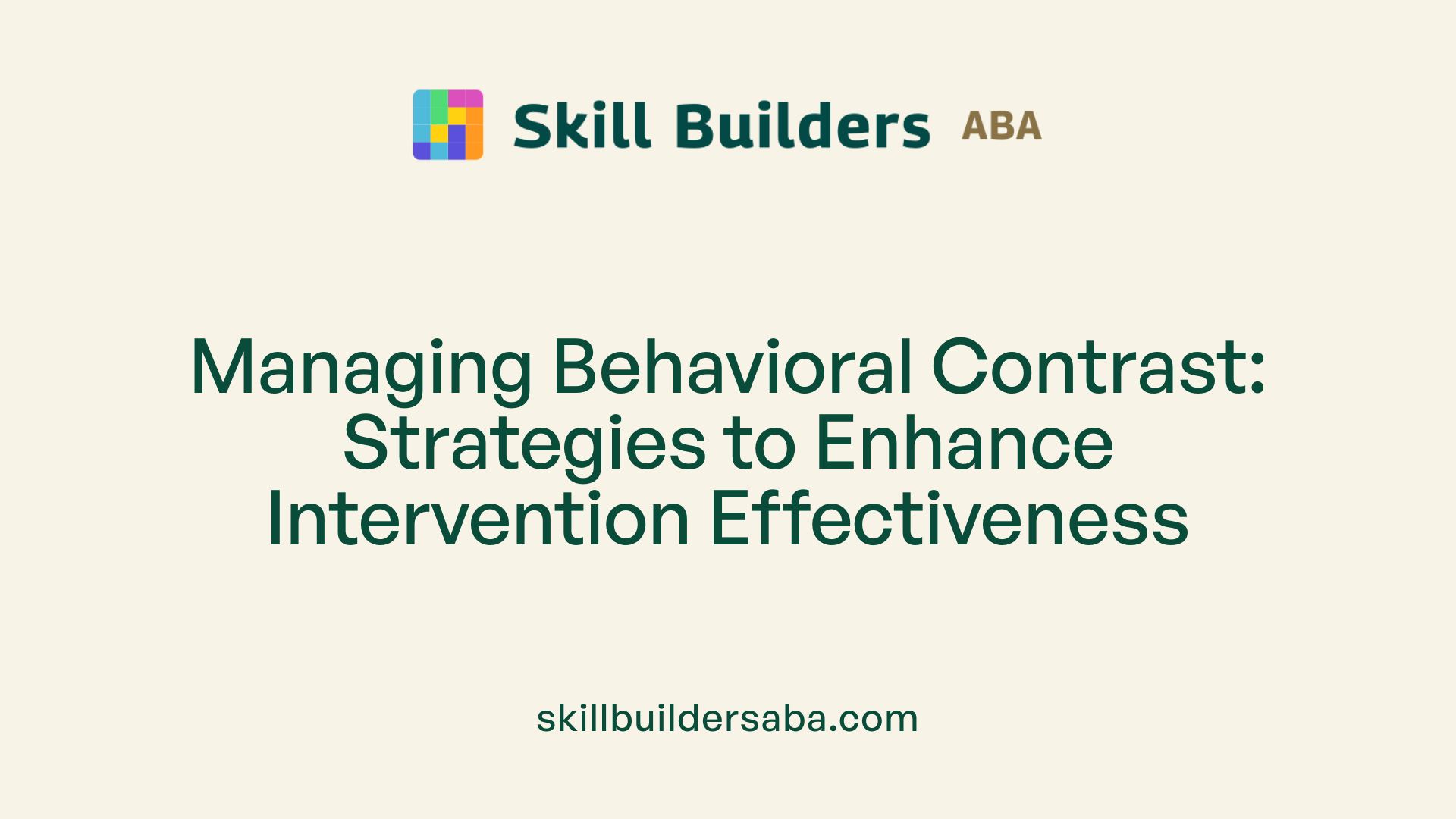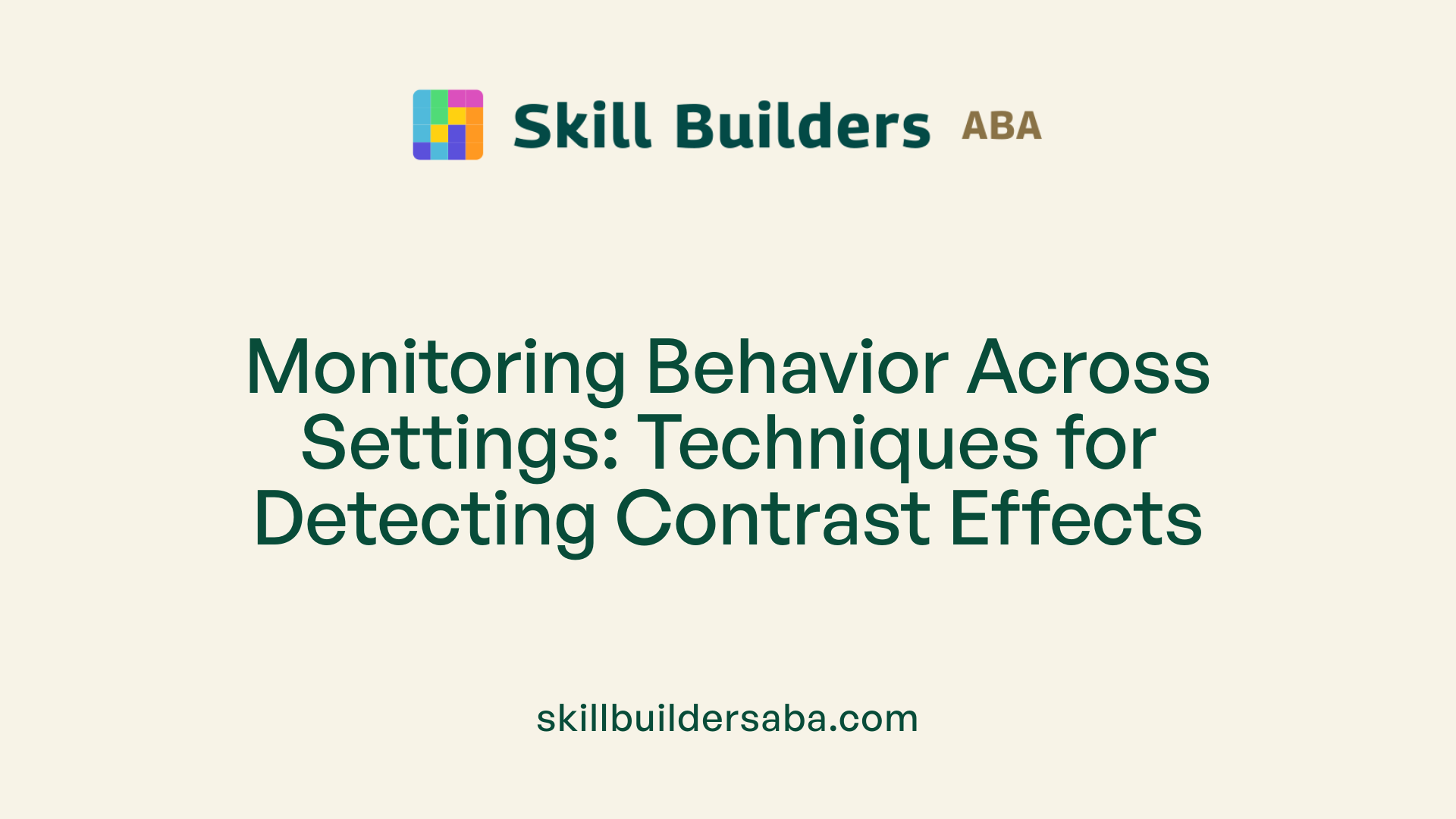
What is behavioral contrast in ABA
Understanding Behavioral Dynamics Across Settings
Introduction to Behavioral Contrast in ABA
Behavioral contrast is a fundamental concept in Applied Behavior Analysis (ABA) that illustrates how behaviors can change across different environments and contexts. It is particularly important for practitioners to consider because it influences the effectiveness of interventions aimed at modifying behavior. This article explores what behavioral contrast is, provides real-world examples, discusses strategies for managing it, and examines its relationship with the matching law in ABA.
Defining Behavioral Contrast in ABA

What is behavioral contrast in Applied Behavior Analysis (ABA)?
Behavioral contrast in ABA is a phenomenon where changes in reinforcement conditions in one setting lead to opposite changes in behavior in another setting. Specifically, when a behavior is reinforced or punished in one context, its occurrence may increase there but decrease in a different context where reinforcement remains unchanged.
This effect can occur as a side effect of reinforcement, punishment, or extinction procedures, and it reflects how behavior adjusts across different situations. For example, if a teenager is punished for swearing at home, they might reduce that behavior at home but increase swearing when with peers, where no punishment occurs.
How does behavioral contrast manifest in behavior change?
Behavioral contrast shows up as an increase in a target behavior in one setting while that same behavior decreases in another setting. This pattern indicates that behavior is sensitive to the reinforcement or punishment present in each environment. It helps practitioners understand that altering consequences in one area can influence responding in another, even when no direct change happens there.
What is the role of reinforcement and punishment?
Reinforcement and punishment are core to behavioral contrast. When reinforcement is provided in one setting, it can boost behaviors there but inadvertently cause a decline elsewhere. Conversely, punishing or reducing reinforcement in a specific area may decrease a behavior locally but lead to an increase outside that setting.
Practitioners recognize this phenomenon as a natural response to changes in consequences. It emphasizes the importance of considering multiple environments when applying interventions, as behavior in one setting can have unintended effects in another. Exploring practitioner experiences with behavioral contrast reveals how these effects inform more holistic behavior management strategies.
| Aspect | Description | Example |
|---|---|---|
| Definition | Change in one setting causes opposite change elsewhere | Increased compliance at school leads to decreased compliance at home |
| Manifestation | Behavior increases in one context, decreases in another | Swearing reduces at home, increases among peers |
| Influencing factors | Reinforcement, punishment, extinction | Punishing tantrums at daycare, leading to fewer tantrums there but more at home |
| Practical relevance | Affects intervention planning and outcomes | Adjusting consequences in one area may influence responses in others |
Real-World Examples and Practical Applications

Can you provide examples of behavioral contrast in ABA and explain their applications?
Behavioral contrast is observed when a change in reinforcement or punishment in one environment causes an opposite change in behavior in another setting. For example, consider a child who is disciplined for eating cookies when visiting their grandmother. As a result, the child might decrease cookie intake during her visits but increase it when she is not around. This demonstrates how behavior can shift across environments due to differing consequences.
In daily life, such patterns are common. Teenagers might face punishment for swearing at home, leading them to swear less there but more with friends. This demonstrates that behavior changes are not isolated to one specific context but are influenced by where reinforcement or punishment occurs.
Understanding these dynamics is crucial for practitioners designing intervention plans. Recognizing that behavior in one setting can influence or be influenced by results in another allows for a more holistic approach. For instance, if an ABA therapist notices a child's behavior worsening in a particular environment, they can consider adjusting reinforcement strategies there, knowing it may affect behavior elsewhere.
In managing behaviors across different settings, behavioral contrast emphasizes the importance of consistency and the contextual effects of consequences. Interventions become more effective when they account for how behavior shifts based on the reinforcement contingencies present in multiple environments.
Behavioral contrast also underscores the importance of coordination among caregivers, teachers, and therapists. By aligning consequences across settings, they can more reliably shape adaptive behaviors.
Below is a summary table illustrating examples and implications:
| Example | Setting | Behavior Change | Reinforcement or Punishment | Application |
|---|---|---|---|---|
| Child eating cookies | When Grandma is present | Decrease cookie intake | Punishment during visits | Adjust reinforcement to promote consistent behavior |
| Teen swearing | At home vs. with peers | Decreased at home, increased with peers | Punishment at home, no punishment with peers | Coordinate consequences across environments |
| Student participation | During classroom vs. after-school | Increased in one setting, decreased in another | Reinforcement in one, extinction in another | Balance reinforcement to maintain desired behavior across settings |
Both the matching law and behavioral contrast are natural human behavior phenomena rooted in consequences, but they describe different aspects. Matching law explains how response allocations relate proportionally to available reinforcement efforts, while behavioral contrast focuses on how the change in consequences in one environment impacts behavior in another.
By understanding and applying these concepts, practitioners can better manage and predict behavior changes, leading to more effective treatment plans.
Strategies for Managing Behavioral Contrast
What strategies can be used to manage behavioral contrast in ABA interventions?
Handling behavioral contrast effectively requires a thoughtful approach to intervention planning. Consistency in reinforcement across different environments is crucial. When reinforcement is not uniform, it can lead to behavior increasing in one setting due to reinforcement in another, even if nothing changes in the original environment.
A common strategy is to systematically fade reinforcers to avoid satiation. Overusing a particular reinforcement can reduce its effectiveness and cause behaviors to shift or intensify elsewhere. Carefully fading these reinforcers helps maintain motivation and consistency.
Teaching self-management skills empowers individuals to regulate their behaviors independently. When people learn to monitor and control their responses, the influence of external reinforcement or punishment becomes less impactful, reducing the likelihood of behavioral contrast.
Utilizing natural reinforcers is also beneficial. These are reinforcers that naturally occur in the environment, such as social praise or access to preferred items, which help behaviors generalize across settings and diminish contrast effects.
Coordination of interventions across different environments is vital. When caregivers, teachers, and therapists collaborate to ensure that reinforcement schedules and consequences are aligned, it reduces conflicting responses and minimizes opposing behavior changes.
Finally, implementing the teaching of replacement behaviors and ongoing monitoring of behavior patterns allow practitioners to identify and address the emergence of contrast phenomena early. This proactive approach sustains more stable, adaptive behaviors over time.
| Strategy | Description | Benefits |
|---|---|---|
| Consistent reinforcement | Match reinforcement across environments | Reduces opposing behaviors and promotes generalization |
| Fading reinforcers carefully | Gradually reduce reinforcement intensity to prevent satiation | Maintains motivation and avoids unintended increases |
| Teaching self-management | Equip individuals with skills to regulate behavior | Encourages independence and reduces external influences |
| Using natural reinforcers | Incorporate everyday reinforcers in varied activities | Facilitates behavior transfer and reduces contrast effects |
| Intervention coordination | Align strategies across all settings | Ensures consistent consequences and reinforcement patterns |
Understanding and implementing these strategies can significantly mitigate the occurrence and impact of behavioral contrast, leading to more effective and lasting behavior change in various settings.
The Relationship with the Matching Law

Explanation of the matching law
The matching law is a fundamental principle in Applied Behavior Analysis (ABA) that describes how individuals tend to distribute their responses among available options in proportion to the reinforcement they receive for each option. In simple terms, if a particular behavior is reinforced more frequently, the person or animal is likely to respond to that behavior more often, balancing responses according to the rates of reinforcement.
How it relates to behavioral contrast
Behavioral contrast occurs when a change in reinforcement in one setting results in an opposite change in behavior in another setting, despite no direct change occurring there. This phenomenon can seem counterintuitive but makes sense through the lens of the matching law. When reinforcement is increased in one environment, responses tend to shift toward that environment, often at the expense of behavior in other settings.
Response allocation and reinforcement
Response allocation refers to how responses are distributed across different behaviors or settings. According to the matching law, this distribution depends on the relative rates of reinforcement each behavior receives. For example, if reinforcement increases in one context, responses in that context typically increase, while responses in other contexts may decrease.
This balance explains behavioral contrast: as reinforcement and responses shift toward the increased reinforcement setting, the behavior in other settings diminishes. Both phenomena demonstrate that consequences—such as reinforcement or punishment—impact behavior not just locally but across multiple environments.
How is behavioral contrast related to the matching law in ABA?
Behavioral contrast exemplifies the matching law by showing how changes in reinforcement conditions lead to shifts in response distribution across different settings. When reinforcement becomes more available in one context, responding there often increases, while responses elsewhere decrease; this reciprocal effect aligns with the proportional response allocation described by the matching law. Essentially, behavioral contrast underscores how response patterns are sensitive to the balance of reinforcement across environments, making these concepts interconnected tools for understanding behavior change in ABA.
Behavioral Contrast in Different Settings and Conditions
How does behavior change across multiple settings?
Behavioral contrast occurs when a person's behavior increases in one setting, like at home, due to reinforcement or punishment in another setting, such as school. This phenomenon happens even if nothing changes directly in the original setting. For example, a child might become more disruptive at home if they are rewarded for similar behaviors at school.
What environmental influences contribute to behavioral contrast?
Environmental factors play a significant role in behavioral contrast. When certain consequences—either positive (reinforcement) or negative (punishment)—are applied in one context, they can lead to an increase or decrease in behaviors in different contexts. This means that changes in one environment can ripple outward, affecting behaviors elsewhere without any direct interventions in those areas.
How do consequences across different contexts impact behavior?
Consequence effects in one setting influence behavior in others, often leading to unintended outcomes. For instance, if a student receives praise and reinforcement for talking during class, they may start talking more at home to seek similar attention. Conversely, if they are punished for a behavior in one setting, it might unintentionally lead to an increase in the same behavior elsewhere, due to a form of behavioral contrast.
Understanding through the matching law and practitioner experiences
The matching law helps explain how responses are distributed based on effort and available reinforcement across settings. Both the matching law and behavioral contrast are natural human responses stemming from consequences. Practitioners observe behavioral contrast through surveys and experience reports, which highlight how interventions can produce these effects across different environments.
| Concept | Explanation | Application |
|---|---|---|
| Behavioral contrast | Change in behavior in one setting due to reinforcement or punishment in another | Guides behavior management strategies |
| Matching law | Response allocation proportional to reinforcement | Helps predict behavior shifts |
| Environmental influences | External settings and their consequences affect behaviors | Essential in treatment planning |
This understanding helps practitioners tailor interventions better, recognizing that changing behavior in one setting may influence behaviors in others, for better or worse.
Historical and Theoretical Foundations of Behavioral Contrast
Roots in behavioral theories
Behavioral contrast is grounded in fundamental principles of behavior analysis that emphasize the role of consequences. It describes a phenomenon where an individual’s behavior increases in one setting because of reinforcement or contact with punishment/extinction elsewhere. This concept aligns with broader behavioral theories which focus on how context and consequences influence actions.
Research and practitioner observations
Practitioners and researchers have observed behavioral contrast through various clinical experiences and empirical studies. They note that behavior can change across different settings, not due to direct intervention in every environment, but because of the way consequences in one context impact behavior in another. Surveys of special education and ABA professionals validate that behavioral contrast is a real and significant phenomenon in managing behavior.
Importance for ABA
Understanding behavioral contrast is vital for effective intervention planning. It helps practitioners anticipate unwanted side effects when modifying behavior in one setting, knowing reactions might occur elsewhere. Recognizing this effect enables more comprehensive and accurate behavior change strategies, emphasizing the importance of considering the broader behavioral environment. Overall, behavioral contrast offers critical insight into how behavior adapts across varied contexts, reinforcing the importance of a systemic approach in applied behavior analysis.
Research and Practitioner Perspectives on Behavioral Contrast
Survey Findings
Research into behavioral contrast, particularly through surveys of practitioners, reveals that it is a well-recognized phenomenon within applied behavior analysis (ABA). Practitioners report observing instances where a change in behavior occurs in one setting due to reinforcement or punishment in another, even when no direct changes are made within the original environment. These surveys show that behavioral contrast can significantly impact how interventions are designed and modified.
Field Observations
In the field, behavior analysts frequently encounter behavioral contrast as part of their routine work. They notice that behavior can increase in a specific setting after reinforcing behavior elsewhere or following extinction procedures. Such observations support the idea that consequences in one context influence behavior in another, often in ways that can complicate treatment plans. This phenomenon underscores the importance of considering environmental and contextual factors when assessing behavior change.
Implications for Practice
Understanding behavioral contrast is essential for effective intervention. It helps practitioners anticipate and manage unexpected shifts in behavior across settings. Recognizing that consequences in one environment can influence behavior elsewhere allows for more strategic planning, avoiding unintended increases in problematic behaviors or decreases in desirable ones. These insights highlight the importance of holistic and coordinated intervention approaches.
Additional Context
Both the matching law and behavioral contrast stem from natural human responses to consequences. The matching law explains response allocation based on reinforcement efforts, whereas behavioral contrast describes the behavioral changes triggered by differential reinforcement or punishment across settings. Exploring practitioner experiences with behavioral contrast ensures interventions are grounded in real-world observations, improving their efficacy.
| Aspect | Description | Additional Notes |
|---|---|---|
| Focus | Behavior change across different settings | Based on consequences in one environment influencing another |
| Underlying theory | Natural response to reinforcement and punishment | Rooted in human and animal behavior studies |
| Practical relevance | Guides intervention adjustments | Key for avoiding unintended behavior escalation |
Impacts of Behavioral Contrast on Behavior Change Interventions

Intervention Design Considerations
In applied behavior analysis (ABA), understanding behavioral contrast is essential for designing effective interventions. When reinforcement is provided in one setting, it can unintentionally increase behaviors elsewhere, even without changes in the original environment. Professionals need to consider how manipulating reinforcement schedules or consequences in one context might influence behavior in another setting. For instance, if a child receives positive reinforcement at school but faces different consequences at home, behavioral contrast might cause behaviors to increase at home, complicating intervention efforts.
Potential Pitfalls
One common challenge in managing behavioral contrast is misinterpreting its effects. It can be mistaken for other behavioral issues, leading to incorrect adjustments in intervention plans. If practitioners are unaware of this phenomenon, they may inadvertently reinforce undesirable behaviors in one setting while attempting to decrease them in another. Additionally, failing to coordinate reinforcement and consequences across settings can create conflicting stimuli that destabilize behavior changes.
Enhancing Intervention Effectiveness
To maximize intervention success, practitioners should monitor behavior across multiple settings and consider the broader environmental context. By aligning reinforcement strategies and consistently applying consequences, they can mitigate unwanted effects of behavioral contrast. Moreover, understanding the matching law—how response allocation correlates with reinforcement effort and availability—helps professionals anticipate how changes in one environment may influence responses elsewhere. Regular assessment and adjustment of reinforcement schedules ensure interventions are responsive to the dynamic interactions of behaviors influenced by behavioral contrast.
| Aspect | Consideration | Practical Example |
|---|---|---|
| Reinforcement distribution | Be aware that reinforcement in one setting can increase behaviors in another | Reinforcing good behavior at school might lead to more talkative behavior at home if not managed thoughtfully |
| Cross-setting consistency | Coordinate reinforcement and consequences across environments | Ensure both home and school teams understand and implement similar reinforcement strategies |
| Behavior monitoring | Continuously observe responses in all relevant settings | Use daily logs or video recordings to track behavioral changes and adjust interventions |
Understanding the phenomenon of behavioral contrast allows practitioners to anticipate and strategize around it, leading to more durable and contextually appropriate behavior change outcomes.
Monitoring and Assessing Behavioral Contrast

Behavior Observation Techniques
To effectively monitor behavioral contrast, practitioners often utilize a combination of direct and indirect observation methods. Direct observation involves systematically recording behavior in different settings using tools like continuous recording, interval sampling, or event recording. Indirect methods include interviews, questionnaires, and behavioral checklists completed by caregivers or educators. These techniques help identify patterns of behavior that change across environments, highlighting instances where an increase in behavior in one setting corresponds to reinforcement or contact with punishment in another.
Data Collection Methods
Accurate data collection is critical in detecting behavioral contrast. Methods such as ABC (Antecedent-Behavior-Consequence) data records can help trace how environmental factors influence responses across settings. Collecting data over time allows for a comparison between baseline and intervention phases, making it easier to spot behavioral shifts. Graphing data visually also aids in recognizing emerging contrast effects, allowing practitioners to adjust interventions accordingly.
Identifying Contrast Effects Early
Early detection of behavioral contrast is crucial for effective intervention adjustments. Practitioners should regularly review collected data to observe discrepancies or sudden increases in behavior in specific settings. Training staff to recognize when behavioral changes occur in response to reinforcement or extinction in other contexts ensures swift responses. Recognizing early signs of contrast supports proactive planning, preventing maladaptive behavior escalation and enhancing intervention outcomes.
| Technique | Purpose | Useful for |
|---|---|---|
| Direct Observation | Record behavior in real-time across settings | Detecting shifts due to environmental factors |
| ABC Data Collection | Trace antecedents, behaviors, and consequences systematically | Understanding influence of reinforcement and punishment |
| Graphical Data Analysis | Visualize changes in behavior over time | Early detection of contrast effects |
| Staff and Caregiver Checklists | Gather broad perspectives on behavior patterns | Confirming observer findings and noticing trends |
Monitoring behavioral contrast continuously ensures that practitioners can adjust strategies promptly, ensuring interventions remain effective across various environments.
The Role of Extinction and Punishment in Behavioral Contrast
Effects of extinction
Extinction plays a significant role in behavioral contrast, especially when applied to undesirable behaviors. When a behavior that was previously reinforced is no longer followed by reinforcement, it might initially decrease. However, in some cases, the behavior may increase in other settings where reinforcement or contact with punishment persists, exemplifying behavioral contrast. For instance, if a child’s tantrums are ignored in the classroom (extinction), they might increase in the home setting because the child seeks attention elsewhere, illustrating how extinction in one context can lead to a rise in behavior in another.
Effects of punishment
Punishment can also influence behavioral contrast. When punishment is applied in one setting, it might suppress behavior there but inadvertently cause an increase in the same behavior or a different one in another setting. This occurs because the consequence in one setting affects overall motivation and response patterns, even without direct changes to the other environment. For example, if a student faces punishment for disruptive behavior at school, they might increase disruptive activities at home as a way to seek the reinforced response that was previously linked to escape from punishment.
Interaction with reinforcement
Both extinction and punishment interact with reinforcement to shape behavior across different settings. Behavioral contrast emerges when the consequences in one setting—be it reinforcement, extinction, or punishment—alter behavior in another setting independently of any direct change there. Understanding this interaction helps practitioners design more effective interventions, recognizing that modifications in one environment may have unintended consequences elsewhere.
Overall, behavioral contrast underscores the importance of considering multiple environments when managing behavior. It demonstrates that consequences in one setting can lead to unexpected increases or decreases of behaviors in others, driven by how reinforcement and punishment influence response patterns across contexts.
| Concept | Impact on Behavior | Additional Notes |
|---|---|---|
| Extinction | May lead to increased behavior in alternative settings | Behavior can increase temporarily before decreasing |
| Punishment | May cause escalation of behaviors elsewhere | Possible development of covert or differing response patterns |
| Response to reinforcement | Cross-setting influence on behavior patterning | Reinforcement in one setting can encourage responses in another |
This understanding aids practitioners in anticipating these effects and tailoring interventions to mitigate unwanted behavioral contrasts, ensuring improvements are consistent across various environments.
Summary and Future Directions in Research
Current Understanding of Behavioral Contrast and Matching Law
Behavioral contrast is a phenomenon observed in Applied Behavior Analysis (ABA), where a change in behavior occurs in one setting due to reinforcement or punishment in another environment. This often results in an increase in behavior even when the original setting remains unchanged. It provides a lens to understand how behavior can vary across different contexts.
The matching law complements this understanding by illustrating how responses are allocated proportionally based on the efforts and reinforcement available in different settings. Both concepts emphasize the influence of consequences on behavior, rooted in natural human response patterns.
Behavioral contrast is considered an important aspect of behavior change, reflecting how consequences in one environment can indirectly affect behavior elsewhere. This phenomenon is not just theoretical; it is supported by practitioner experiences and empirical studies, underlining its practical relevance.
Gaps in Knowledge
While behavioral contrast is recognized, there are gaps in understanding its underlying mechanisms. It is unclear how different contextual factors specifically interact to produce either increases or decreases in behavior. Additionally, the influence of various types of reinforcement and punishment on behavioral contrast across diverse settings remains underexplored.
Further, although practitioners observe behavioral contrast regularly, more systematic research is needed to quantify the phenomenon and determine its variables. This would enhance the ability to predict and manage behavior changes more effectively.
Potential Research Avenues
Future research could investigate the causal mechanisms behind behavioral contrast more deeply, using controlled experimental designs. Studies might explore how different reinforcement schedules or extinction procedures in one setting influence behavior in another.
Research could also examine variation across different populations and settings to identify factors that modify the strength or direction of behavioral contrast. Developing predictive models that incorporate variables like reinforcement effort or punishment types might also improve intervention strategies.
Ultimately, expanding the empirical foundation of behavioral contrast in ABA will help practitioners optimize interventions across variable environments, resulting in more reliable behavior change outcomes.
| Aspect | Focus | Future Research Potential |
|---|---|---|
| Understanding | Mechanisms of behavioral contrast | Controlled experiments to explore causality |
| Variables | Factors influencing contrast | Identification of moderating variables |
| Applications | Intervention strategies | Developing predictive models |
This ongoing exploration promises to clarify the complex ways in which consequences shape behavior across diverse settings, advancing both theory and practice in ABA.
Final Thoughts on Behavioral Contrast
Understanding behavioral contrast is crucial for effective ABA practice, as it highlights how behaviors can change in multiple settings based on reinforcement patterns. By recognizing this phenomenon, practitioners can better anticipate, monitor, and manage shifts in behavior, leading to more successful intervention outcomes. Ongoing research and practitioner insights continue to expand our understanding of behavioral contrast, informing future strategies and theoretical models in behavioral science.
References
- Matching Law Versus Behavioral Contrast in ABA - PTB
- Behavioral contrast: An exploratory survey of practitioner ...
- Behavioral Contrast
- Behavior Contrast
- Behavior Contrast
- Behavioral contrast: An exploratory survey of practitioner ...
- B.23 Understanding the Matching Law and Response ...
- Unwanted Effects of Interventions - Section H-5
- Behavioral Contrast
Reach Out Today
Learn more about how we can support your child’s growth and development. Contact us to discuss our services and availability in your area.
.svg)